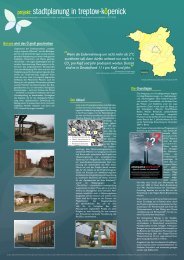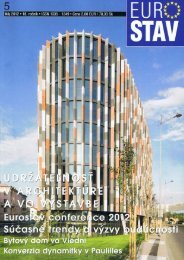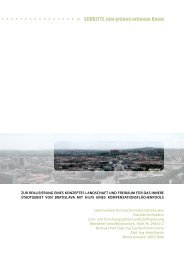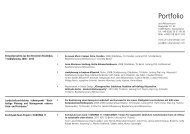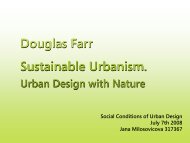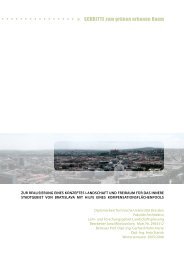Thesis document - Jana Milosovicova - Urban Design English
Thesis document - Jana Milosovicova - Urban Design English
Thesis document - Jana Milosovicova - Urban Design English
- No tags were found...
Create successful ePaper yourself
Turn your PDF publications into a flip-book with our unique Google optimized e-Paper software.
• Reduce quantity of lanes, where appropriate. Introducetraffic calming areas (“Tempo 30” zones), which enablesmerging lanes and thus reduces the paved road width to lessthan if there were two lanes in opposite direction.• Implement traffic calming measures that involve perviouspavement.• Increase landscaping within sidewalk areas.• Use alternative soil stabilization resins to provide walkingor vehicle surfaces in light-traffic areas such as park walks andbike paths.• Share parking between businesses with different peak parkingdemand schedules.• Use the smallest allowable dimensions for regular parkingstalls; reduce row parking area that requires the most parkingspace.• Base parking lot design on average parking needs rather thanpeak parking needs.EvaporationWaste waterCondensed vapour retentionCaptured clean waterused for irrigation ofopen spaces andgreen roofs/evaporative coolingFig. 66 Wastewater use for UHI-mitigatingmeans. Wastewater collection, cleaning evapotranspiration,capturing of the condensedvapour and re-use.• For streets with a gradient in excess of 5%, use check dams toslow the flow of stormwater and allow for greater infiltration anduptake of water by plants.Manage the wastewaterWastewater may serve as a useful by-product of the urban system.Wastewater may be collected and evaporated within a closed facility –and the clean, condensed vapour used preferably in a way that helpstackle the UHI – such as irrigation of the open space or evaporativecooling. As such, the water cycle will be closed while using the watereffectively three or four times (harvesting of wastewater → water vapourre-use (e.g. toilet flushing) → irrigation) (fig. 66).Special design details of buildings affectingoutdoor conditionsReduce the side effect of abundant heat rejection by conventionalair conditioning in buildings into the adjacent environment by:• using adiabatic cooling systems combined with façade androof greenery (See Case study Institute of Physics in Berlin-Adlershofin Appendix 5).• introducing the water cooling effect in form of cooling towersas part of built structures (with the effect of direct evaporative aircooling) or ponds on rooftops with water as a cooling medium(indirect evaporative roof cooling) (Givoni 1998, p. 196-205).• placing the condensers of conventional air conditioningsystems at roof level (when implementation of these systems forsome reasons unavoidable). This rejects the heat high above thestreets, with minimum impact on the ground-level air temperatures(Givoni 1998, p. 283), however still increasing the adjacent urbanair temperature.46Climate Sensitive <strong>Urban</strong> <strong>Design</strong> in Moderate Climate Zone: Responding to Future Heat Waves. Case Study Berlin Heidestrasse/Europacity



